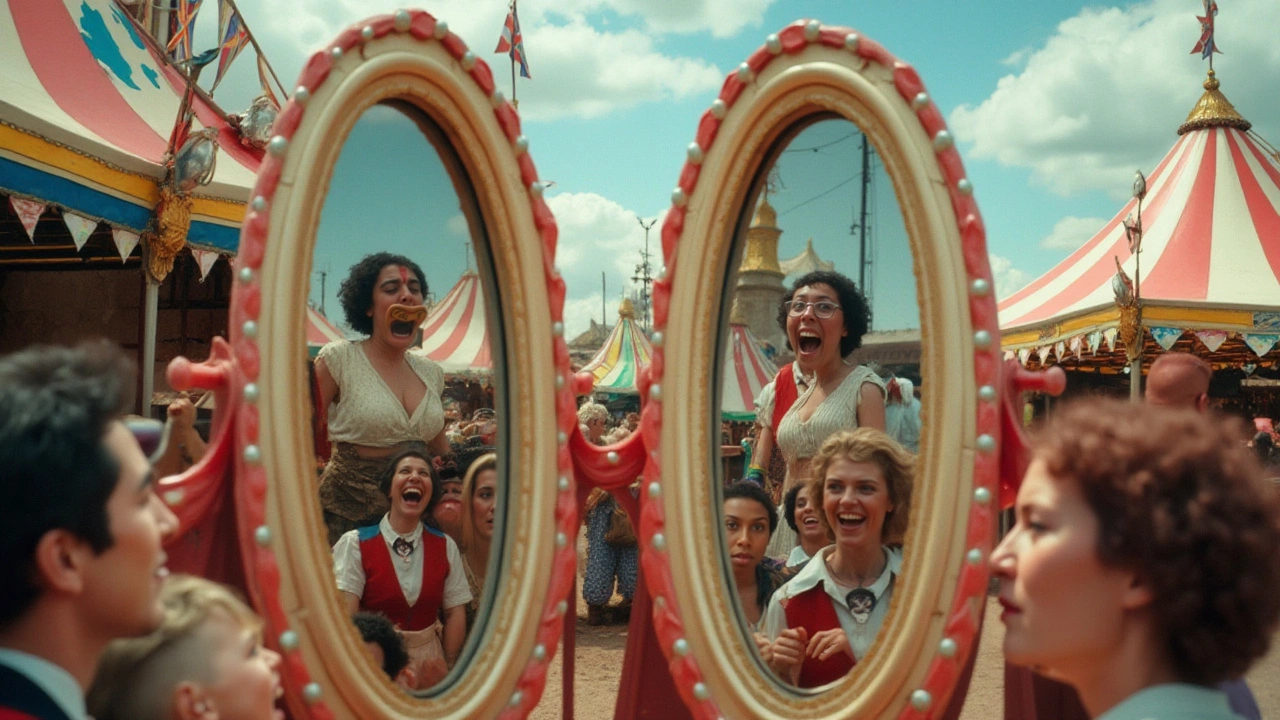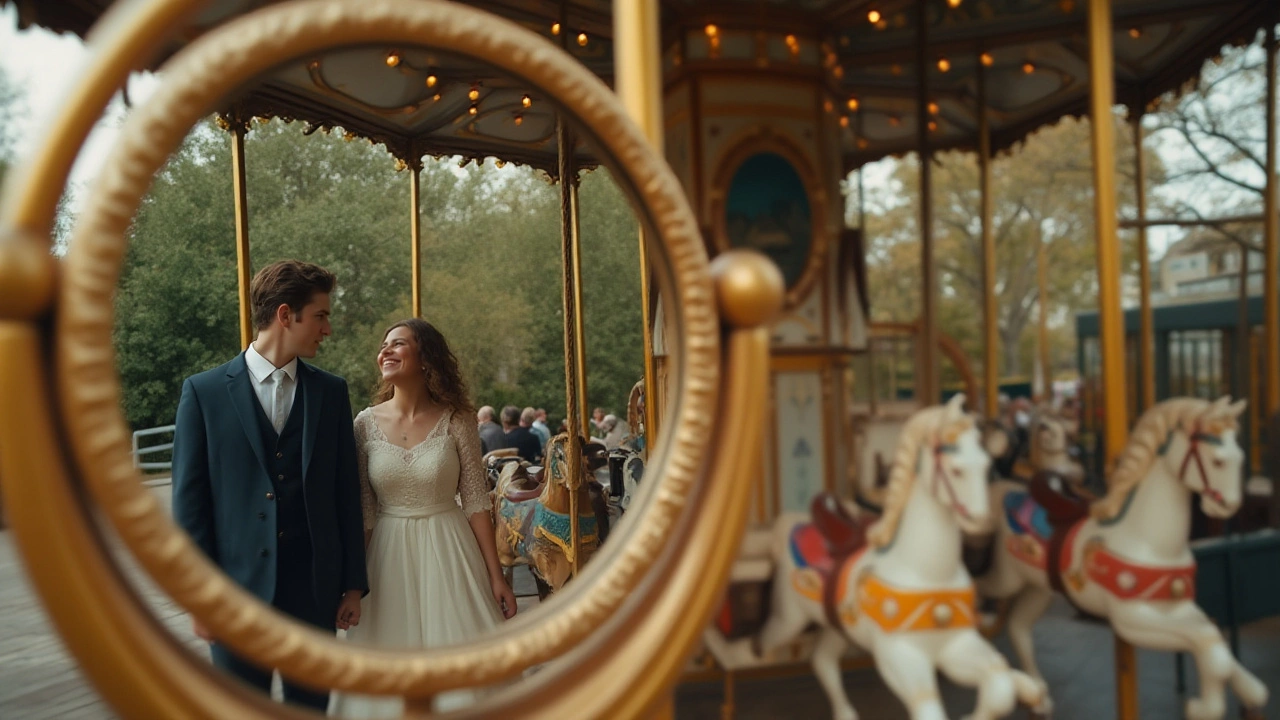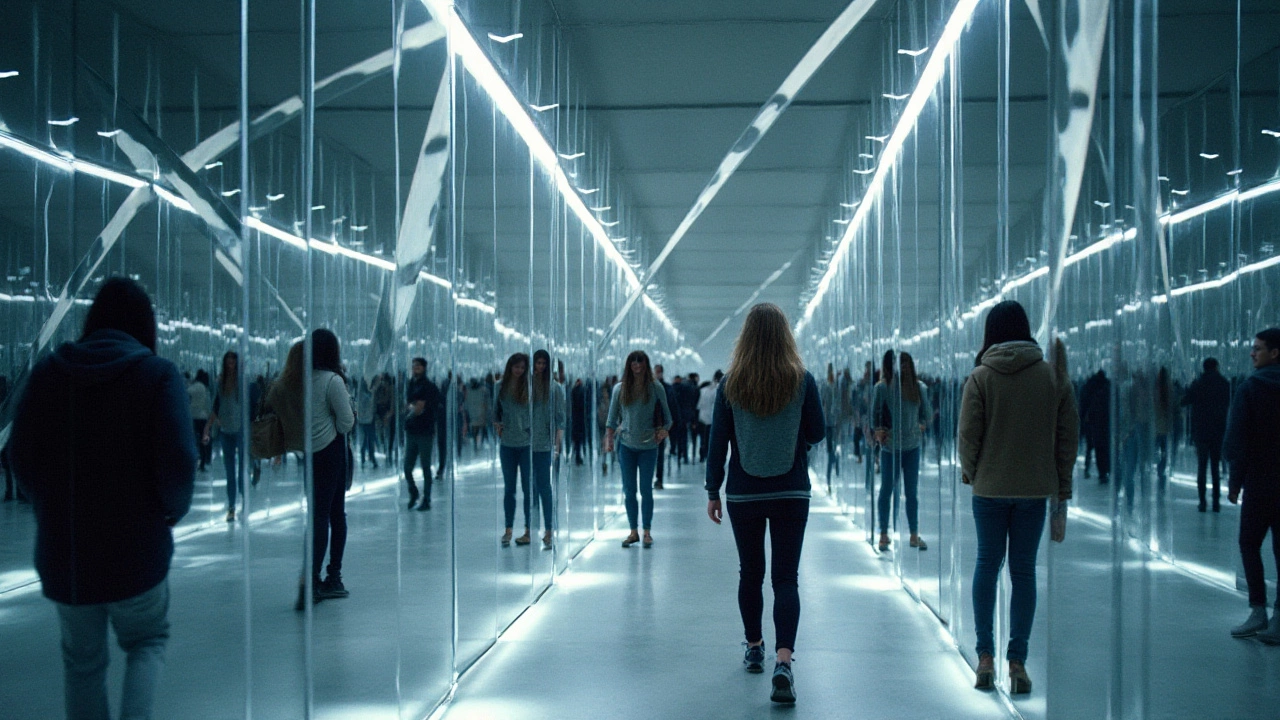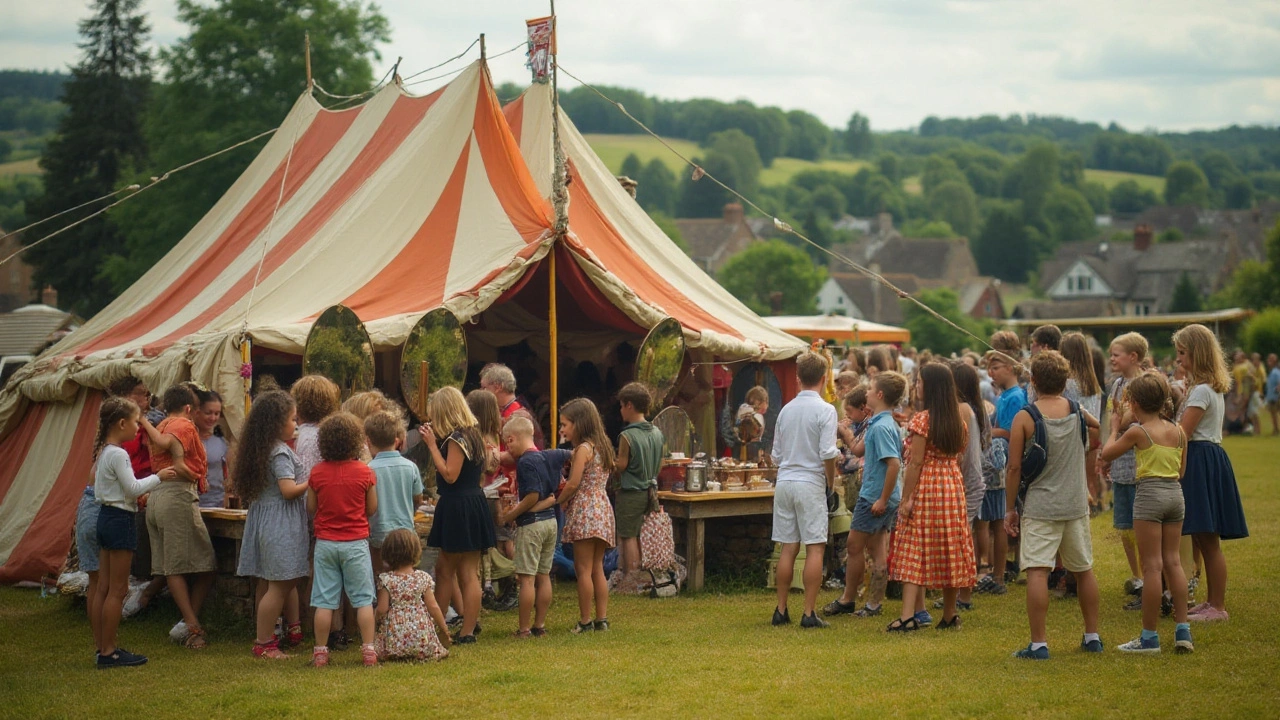Exploring the Fascinating World of Funhouse Mirrors
 Dec, 14 2024
Dec, 14 2024
Have you ever stepped into a funhouse, only to be greeted by a reflection that seems to belong to someone else entirely? Those wacky, whimsical mirrors, known as funhouse mirrors, have turned our perceptions on their heads for over a century. From their early days in European carnivals to their place in today's amusement parks, these mirrors provide endless entertainment.
The charm of funhouse mirrors lies in their ability to stretch reality, bending light and our expectations simultaneously. By using strategically curved surfaces, these mirrors create unique illusions that stretch, shrink, or distort our figures in amusing ways. But there's more to these mirrors than just their playful side. Let's step behind the mirror, so to speak, and explore where they came from, how they evolved, and why their appeal remains timeless.
History and Origin
The allure of funhouse mirrors traces back centuries, to an era where entertainment took on a more physical form in the bustling streets of Europe. These whimsical mirrors became a staple in the traveling carnivals that filled the town squares with laughter and curiosity. The original concept of distorted reflections is thought to be inspired by the ancient practice of experimenting with reflections in still water, bending perceptions long before the industrial age made such thrills more accessible. Early adopters of these mirrors noticed that by curving glass in precise manners, they could create effects that entertained royals and peasants alike, effectively turning optical physics into a form of art and wonder.
As these type of mirrors evolved, the industrial revolution played a significant role in their proliferation. Advances in glass-making techniques allowed for greater experimentation and refinement in producing these mirrors, enabling the creation of dazzling displays in permanent settings such as amusement parks. Facilities dedicated to 'hall of mirrors' delightfully confused and entertained visitors with rooms filled with reflective trickery. It’s fascinating to realize that these mirrors, almost paradoxical in their simplicity and complexity, catalyzed a series of public amusement forms that continue to evolve today.
According to historical records, one of the first documented uses of a dedicated 'house of mirrors' was found at the Gavioli Pleasure Gardens in Tivoli, Denmark, in the late 19th century. As cities industrialized, permanent amusement parks adopted these features, notably in places like Coney Island in the United States. This transition from temporary installations in traveling shows to fixtures in permanent parks marked a shift in how society consumed leisure and art. By the turn of the 20th century, these funhouse mirrors became synonymous with entertainment spaces, embedding themselves in the cultural fabric of festive activities.
There is an interesting intersection between art and science underpinning these reflective illusions. A fascinating quote exemplifying this sentiment comes from the famed physicist Richard Feynman, who once said in a broader context of how we see the world:
"I think nature's imagination is so much greater than man's. She's never gonna let us relax."This quote captures the essence of distorted mirrors - reflections that ignite curiosity and storytelling through the playful manipulation of light and perspective.
Today, these mirrors not only preserve their place in traditional settings but inspire artists and creators across disciplines to explore perspectives and realities as diverse and vast as the imaginations they spark. From installations in contemporary art museums to their influence on the world of virtual reality, mirrors that warp our view of the world continue to intrigue by tapping into the timeless human love for surprise and spectacle.

How They Work
When you step in front of a funhouse mirror, the playful transformation you witness isn't magic; it's all about physics, light, and geometry. At the heart of these entertaining mirrors lies the manipulation of light through strategic curvatures. A basic understanding of how light reflects off surfaces gives us a clue to their working. Typically, a flat mirror reflects light directly back at you, creating a straightforward reflection. However, distorted mirrors feature concave or convex surfaces where light bends at various angles, earning them their delightful distortion characteristics.
Each type of curvature has its own mischievous way of altering reflections. A concave mirror, which curves inward like a spoon, can make you appear taller or thinner, depending on where you're standing in relation to the mirror's focus. Convex mirrors, on the other hand, bulge outward and are more likely to make you look short and wide, akin to a flattened rubber ball. This is why the placement of these mirrors is crucial in achieving the desired comedic effect. The variations in thickness and curvature allow creators to craft mirrors tailored to amaze and amuse audiences at carnivals and carnival mirrors displays. Interestingly, modern mirror manufacturing techniques make this more precise than ever.
Our perceptions and expectations also play a big role. The brain tries to make sense of these distorted images, often leading to laughter and surprise. The novelty and excitement experienced when encountering these mirrors originate from the unique human ability to recognize when the brain's prediction models don't align with reality. According to Dr. Rachel Wilson, a cognitive scientist, the human mind is "wired to identify patterns and discrepancies."
"The joy of unexpected reflections is an ancient form of entertainment," she notes. "It's an instant connection between the physical and cognitive realms."The brain gets involved in this fun cognitive puzzle, and our reaction is delight.
The intrinsic amusement aside, these mirror reflections captivate us by challenging the conventional understanding of mirrors as mere reality reflectors. It's fascinating to note that similar principles apply in different scientific areas. For instance, astronomers use parabolic mirrors in telescopes to focus light from distant stars, allowing them to view the universe with clarity. It's a thrilling thought to connect the whimsical side of mirrors with such profound explorations and add depth (both literal and metaphorical) to the space exploration narrative. It goes to show how something commonly seen at fairgrounds shares principles with scientific tools designed for the very grand task of exploring the cosmos.

Cultural Impact
The enigmatic appeal of funhouse mirrors has woven an enduring thread through the tapestry of entertainment and art. These whimsical objects transcend mere amusement; they serve as metaphors for the human experience. In literature and film, distorted mirrors often symbolize altered perceptions, mirroring the fluctuating nature of identity and truth. From the satirical reflections in Lewis Carroll’s "Through the Looking-Glass" to the symbolic use in the surrealist works of Salvador Dalí, these mirrors have inspired creators to explore the contours of imagination and reality.
Amusement parks across the globe owe much of their charm to these curious mirrors. They are not just fixtures of funhouses; they are cultural icons. The playful distortions they offer invite laughter and leave lasting impressions, drawing countless visitors to their wacky worlds every day. Such experiences are so universally enticing that they have transcended their origins, becoming popular permanent installations in museums and art exhibits. For instance, artist Yayoi Kusama's mirror installations transform entire rooms into kaleidoscopic wonderlands, drawing throngs eager to lose themselves in infinite reflections.
In modern media, the metaphorical influence of funhouse mirrors is profound. They are often used to depict self-reflection and the distorting effects of external pressures on personal identity. In cinema, filmmakers employ these reflections to convey characters' internal struggles and transformations. Reminiscent of the distortions seen in films like "The Matrix" or "Black Swan," these visual cues speak to audiences on a psychological level, using the power of reflection to explore deeper narratives.
"Funhouse mirrors remind us that our perceptions are mutable and reality can be as fluid as it is fixed," mused renowned photographer Ansel Adams in an interview discussing the symbolic weight of distorted mirrors in art.
The cultural fascination with funhouse mirrors isn't just rooted in their visual tricks, but in what they reveal about human nature. In psychological studies, they are often employed to illustrate body image issues and self-perception, echoing the way society's standards can warp personal views. This interplay between mirror and mind prompts a dialogue about the societal and personal filters through which we view ourselves, encouraging introspection and a deeper understanding of identity.
Their resonance with themes of change and reflection has cemented distorted mirrors as powerful tools in cultural storytelling. Whether in galleries showcasing the art of perception or in the plotlines of a blockbuster movie, the magic of these mirrors touches something inherently human. They remind us, through their twists and turns, of the limitations of sight and the boundless expanse of the imagination.

Modern Uses
As time progresses and technology advances, the use of funhouse mirrors has expanded far beyond the boundaries of amusement parks and carnivals. Today, these distorted mirrors are making a significant splash in modern art installations, architecture, and even in the realm of psychological exploration. Their unique ability to alter perception now serves more than just the purpose of entertainment—they are tools for innovation, inspiration, and introspection.
In the art world, funhouse mirrors have achieved a status akin to that of beloved muses. Contemporary artists harness the power of reflection and distortion to challenge viewers, prompting them to question the reliability of their perception. These mirrors are frequently part of immersive art exhibitions where the audience becomes part of the artwork itself. Take Yayoi Kusama's Infinity Mirrors, for example, which utilizes mirrored rooms to create mesmerizing visuals that depict endless space. Such exhibits are more than art—they are experiences that explore the boundaries between reality and illusion.
Beyond art, architects are increasingly integrating funhouse mirrors into their designs to create dynamic, inviting spaces that engage and surprise onlookers. Think of mirrored facades that transform urban landscapes by reflecting the sky or altering the perception of space through strategic placement. Buildings clad in reflective materials often respond to their environments, offering ever-changing views that captivate those who pass by. These applications not only make structures aesthetically pleasing but also environmentally interactive, creating harmony between the built and natural environments.
"Modern architecture becomes more engaging and reflective of its environment when it incorporates elements that mirror their surroundings, modifying our experience of space," says renowned architect Michael Arad.
Funhouse mirrors also play a role in psychological studies, offering researchers a way to probe the intricacies of human perception and cognition. By understanding how curvature and distortion impact our view of the world, scientists can gain deeper insights into visual processing and mental states. They are particularly valuable in studies related to body image and self-perception, helping individuals visualize changes in their appearance in a controlled, experimental setting. A study published in the Journal of Experimental Psychology demonstrated how exposure to distorted mirrors could temporarily alter individuals' self-assessment and confidence levels.
Additionally, these mirrors are making subtle appearances in the fashion industry. Retail stores occasionally use them as creative displays to draw attention and enhance the shopping experience by offering a whimsical break from the norms. Some innovative clothing brands even experiment with funhouse mirrors in fitting rooms to playfully highlight specific garments, enhancing customer engagement through unexpected visual effects.
The evolution of funhouse mirrors in modern contexts proves that these objects, once relegated to sideshows, have found new life in a world ever-hungry for visual intrigue. Whether as a tool for artists or scientists, or simply a novelty in public spaces, they continue to captivate and inspire, reminding us that our perceptions, and life itself, are often a delightful illusion.